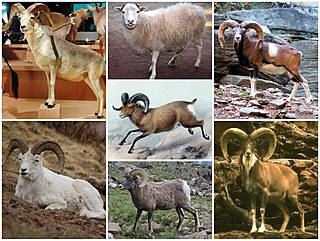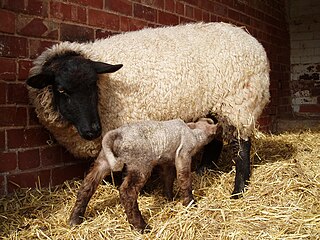
The relationship between biology and sexual orientation is a subject of on-going research. While scientists do not know the exact cause of sexual orientation, they theorize that it is caused by a complex interplay of genetic, hormonal, and environmental influences. However, evidence is weak for hypotheses that the post-natal social environment impacts sexual orientation, especially for males.

The mouflon is a wild sheep native to Cyprus, and the Caspian region, including eastern Turkey, Armenia, Azerbaijan, Georgia and Iran. It is also found in parts of Europe. It is thought to be the ancestor of all modern domestic sheep breeds.

Various non-human animal species exhibit behavior that can be interpreted as homosexual or bisexual, often referred to as same-sex sexual behavior (SSSB) by scientists. This may include same-sex sexual activity, courtship, affection, pair bonding, and parenting among same-sex animal pairs. Various forms of this are found among a variety of vertebrate and arthropod taxonomic classes. The sexual behavior of non-human animals takes many different forms, even within the same species, though homosexual behavior is best known from social species.

Ovis dalli, also known as the Dall sheep or thinhorn sheep, is a species of wild sheep native to northwestern North America. Ovis dalli contains two subspecies: Ovis dalli dalli and Ovis dalli stonei. O. dalli live in mountainous alpine habitats distributed across northwestern British Columbia, the Yukon, Northwest Territories and Alaska. They browse a variety of plants such as grasses, sedges and even shrubs such as willow, during different times of the year. They also acquire minerals to supplement their diet from mineral licks. Like other Ovis species, the rams engage in dominance contests with their horns.

The argali, also known as the mountain sheep, is a wild sheep native to the highlands of western East Asia, the Himalayas, Tibet, and the Altai Mountains.

Ovis is a genus of mammals, part of the Caprinae subfamily of the ruminant family Bovidae. Its seven highly sociable species are known as sheep or ovines. Domestic sheep are members of the genus, and are thought to be descended from the wild mouflon of central and southwest Asia.
The sexually dimorphic nucleus (SDN) is an ovoid, densely packed cluster of large cells located in the medial preoptic area (POA) of the hypothalamus which is believed to be related to sexual behavior in animals. Thus far, for all species of mammals investigated, the SDN has been repeatedly found to be considerably larger in males than in females. In humans, the volume of the SDN has been found to be 2.2 times as large in males as in females and to contain 2.1 times as many cells. The human SDN is elongated in females and more spherical in males. No sex differences have been observed in the human SDN in either cell density or mean diameter of the cell nuclei. The volume and cell number of the human SDN considerably decreases with age, although the decrease in cell number is both sex and age-specific. In males, a substantial decrease in the cell number of the human SDN was observed between the age of 50–60 years. Cell death was more common in females than males, especially among those older than 70 years of age. The SDN cell number in females can drop to 10-15% of that found in early childhood.

Androphilia and gynephilia are terms used in behavioral science to describe sexual orientation, as an alternative to a gender binary homosexual and heterosexual conceptualization. Androphilia describes sexual attraction to men and/or masculinity; gynephilia describes the sexual attraction to women and/or femininity. Ambiphilia describes the combination of both androphilia and gynephilia in a given individual, or bisexuality.
INAH-3 is the short form for the third interstitial nucleus of the anterior hypothalamus, and is the sexually dimorphic nucleus of humans. INAH-3 is significantly larger in males than in females regardless of age. One study has shown that INAH-3 is larger in heterosexual males than in homosexual males and heterosexual females, although this data has not been successfully reproduced.
The fruitless gene (fru) is a Drosophila melanogaster gene that encodes several variants of a putative transcription factor protein. Normal fruitless function is required for proper development of several anatomical structures necessary for courtship, including motor neurons which innervate muscles needed for fly sexual behaviors. The gene does not have an obvious mammalian homolog, but appears to function in sex determination in species as distant as the mosquito Anopheles gambiae.

Teleogryllus oceanicus, commonly known as the Australian, Pacific or oceanic field cricket, is a cricket found across Oceania and in coastal Australia from Carnarvon in Western Australia and Rockhampton in north-east Queensland

A courtship display is a set of display behaviors in which an animal, usually a male, attempts to attract a mate; the mate exercises choice, so sexual selection acts on the display. These behaviors often include ritualized movement ("dances"), vocalizations, mechanical sound production, or displays of beauty, strength, or agonistic ability.

"Domestic" sheep reproduce sexually like other mammals, with a reproductive process similar to other domestic herd animals. A flock of sheep is mated by a single ram, which has either been chosen by a farmer or has established dominance through physical contests with other rams. Sheep have a breeding season (tupping) in the autumn, though some can breed year-round.

Sheep or domestic sheep are a domesticated, ruminant mammal typically kept as livestock. Although the term sheep can apply to other species in the genus Ovis, in everyday usage it almost always refers to domesticated sheep. Like all ruminants, sheep are members of the order Artiodactyla, the even-toed ungulates. Numbering a little over one billion, domestic sheep are also the most numerous species of sheep. An adult female is referred to as a ewe, an intact male as a ram, occasionally a tup, a castrated male as a wether, and a young sheep as a lamb.

The relationship between the environment and sexual orientation is a subject of research. In the study of sexual orientation, some researchers distinguish environmental influences from hormonal influences, while other researchers include biological influences such as prenatal hormones as part of environmental influences.

Sexual orientation is an enduring pattern of romantic or sexual attraction to persons of the opposite sex or gender, the same sex or gender, or to both sexes or more than one gender, or none of the aforementioned at all. The ultimate causes and mechanisms of sexual orientation development in humans remain unclear and many theories are speculative and controversial. However, advances in neuroscience explain and illustrate characteristics linked to sexual orientation. Studies have explored structural neural-correlates, functional and/or cognitive relationships, and developmental theories relating to sexual orientation in humans.

Animal non-reproductive sexual behavior encompasses sexual activities that non-human animals participate in which do not lead to the reproduction of the species. Although procreation continues to be the primary explanation for sexual behavior in animals, recent observations on animal behavior have given alternative reasons for the engagement in sexual activities by animals. Animals have been observed to engage in sex for social interaction bonding, exchange for significant materials, affection, mentorship pairings, sexual enjoyment, or as demonstration of social rank. Observed non-procreative sexual activities include non-copulatory mounting, oral sex, genital stimulation, anal stimulation, interspecies mating, same-sex sexual interaction, and acts of affection, although it is doubted that they have done this since the beginning of their existence. There have also been observations of sex with cub participants, as well as sex with dead animals.











